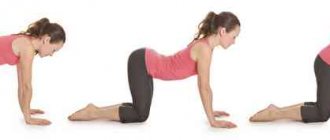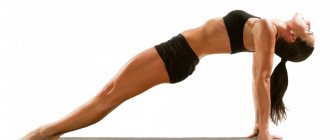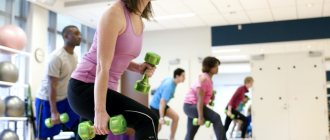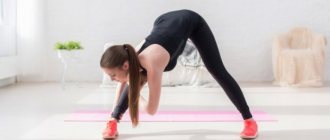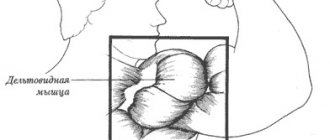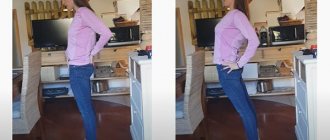The key to developing correct posture is physical activity. But what to do if your posture gradually changes, and not for the better? And it seems that nothing can be done about it, because there is no escape from your sedentary work. It is in such a situation that exercises for straightening the spine come to the rescue. Of course, the best option would be if a doctor selects a set of exercises for you individually. We suggest that you familiarize yourself with the exercise complexes that are used in the general case. They won't do any harm, and will somehow help you improve your posture.
Set of exercises
How to straighten the spine at home depends on which area is involved in the lesion. Each department has its own set of exercises.
For the cervical region
If the vertebrae have shifted in the cervical spine, power techniques are prohibited, since this area is located near the brain.
If gymnastic manipulations are performed incorrectly, cerebral circulation is disrupted, blood pressure increases, dizziness occurs, and visual and auditory functions deteriorate. Exercises for the cervical spine:
- take a position lying on your back on a hard surface, place a bolster or small pillow under your cervical spine so that your head is tilted back, hold in this position for several minutes;
- take a sitting position, slowly turn your head to the sides until it stops, holding each position for 10 seconds; repeat the exercise, tilting your head forward and back;
- carry out self-massage of the cervical spine, knead it, rub it, without involving the spinal column in the manipulation.
Avoid sudden jerks and turns of the head.
For the thoracic region
The anatomical location of the vertebrae in the thoracic region is restored, taking measures to increase the distance between the bodies.
The spine at chest level has less mobility than in other segments, so it is permissible to straighten the thoracic vertebrae yourself at home. Exercises for the thoracic spine:
- hanging on the horizontal bar, grasping the bar with both hands;
- take a kneeling position, rest your hands on the floor (palms down), leave your back straight, move your leg back, trying to straighten it as much as possible, repeat the exercise with the other leg;
- take a position lying on your stomach, stretch your arms forward, placing your palms down, pull your head and neck up, holding them at the maximum point for 2-3 seconds.
For the lumbar region
The vertebral bodies in the lumbar region are often displaced.
This can be explained by the imposition of increased loads on this area and the high mobility of the segments. The lumbar vertebrae are the most difficult to put into place when they are displaced. Exercises for the lumbar spine:
- take a position lying on your back on a hard surface, straighten your lower limbs and cross them in the ankle area, try to turn your pelvis to the right and left so that your feet do not move;
- in the same starting position, bend your legs at the knee joints, place your heels as close to your buttocks as possible, move your arms straight to the sides, twist your body and bend your legs opposite to each other.
Large nerve trunks are located in the lumbar region, so it is not recommended to abuse sudden movements. Otherwise, you may get pinched.
Complex therapy
Non-steroidal anti-inflammatory drugs are prescribed for severe pain.
It is not enough to realign the vertebrae. Treatment should be comprehensive and first of all it is directed to the provoking disease. Conservative or surgical therapy is used.
To suppress the activity of the inflammatory reaction and reduce the severity of pain, painkillers and non-steroidal anti-inflammatory drugs are prescribed. It may be necessary to take antibacterial agents to reduce the risk of infections.
In combination with drug treatment, physiotherapeutic procedures are carried out, for example, exposure to ultrasound, radio waves, reflexology, laser and magnetic therapy. Physical therapy helps stimulate muscles, joints and nerves and restore blood flow to the affected area.
Surgical treatment of vertebral body displacement is practiced in exceptional cases when it is impossible to correct the position using conservative methods.
If you neglect complex therapy, you can cause complications, including:
- disruption of the musculoskeletal system and nearby internal organs: genitourinary, gastrointestinal tract, lungs, brain, etc.;
- development of neurological pathologies;
- impairment of auditory and visual functions.
Sclerosis
This disease is known to cause hardening of the endplates of the vertebral bodies. Cartilage tissue covers the inside of the joint due to degenerative disease.
The connective tissue ceases to perform its function, the bone tissue becomes denser, and growths (osteophytes) form. This pathological process begins to develop for the following reasons:
- problems with the musculoskeletal system;
- injuries and chronic injuries;
- weak back muscles;
- elderly age;
- inflammatory diseases;
- work in one position.
The source can be arthrosis and. The causes of the diseases are different, but in both cases growths form.
With osteochondrosis, osteophytes appear on the edge of the vertebrae. The lumbar and sacral regions are most often affected. This happens due to the fact that more load is placed on the lower back.
If the cervical spine is affected, then the endplates of the vertebrae of the cervical spine become compacted.
When osteochondrosis develops asymptomatically for a long time, osteophytes grow. The result is a single bone formation. But the entire spinal column can suffer.
In arthrosis, osteophytes affect the edges of the joints. Bone growths form instead of cartilage tissue. This interferes with the movement of the joint and causes severe pain.
If the underlying disease is not treated, the growths block and immobilize the joint. Osteochondrosis is irreversible, but arthritis in the early stages is treatable.
With spinal sclerosis, a person experiences severe pain when bending the back and turning the neck, problems with coordination, numbness of the limbs, and muscle weakness. Heavy breathing, weight loss, hearing and memory deterioration are observed.
For diagnosis, the doctor prescribes:
- X-ray examination;
- densitometry;
- MRI and CT;
- blood test to rule out other diseases.
You cannot self-medicate! All folk recipes boil down only to pain relief. Only a doctor can prescribe the correct treatment. Apply
A lump under the skin in the back area is not a rare occurrence. Such a compaction can vary in size, be soft or hard, normal in color or hyperemic, and may be painful or painless. Someone has a rolling ball on the left in the lower back or on the right... The reasons for the appearance of such formations can also be different and only a specialist can make the correct diagnosis and prescribe treatment.
Today we are talking about why a lump under the skin on the spine may appear on the lower back, what diseases cause this phenomenon, and will briefly discuss treatment methods.
Why does a lump appear on the lower back? Possible reasons
Lipoma
Simply put, this is a subcutaneous wen known to many, a benign tumor. Develops as a result of impaired metabolism, due to insufficiency of regulatory enzymes. Or it may be associated with a hereditary predisposition.
Lipoma consists of connective tissue and occurs in the fatty layer under the skin. Soft to the touch, painless. Size - from a small pea to a chicken egg.
Fibroma
The lump is located under the skin and is painless. A benign neoplasm consists of connective and fibrous tissue. The cause is most often trauma or severe irritation of the skin, which causes uncontrolled cell growth. Although many doctors attribute the appearance of fibroids to a hereditary predisposition.
Hemangioma
Typically, this is a red bump under the skin with clear contours, located near the spine. The tumor is benign. Occurs due to disruption of the normal formation of blood vessels. It has the ability to grow quickly to significant sizes.
Atheroma
If a growth under the skin appears in the upper back, it may be atheroma. It develops due to blockage of the sebaceous gland duct. The tumor is benign, soft, painless. Mushy inside, consisting of fat and epithelial cells.
Can grow quickly. Sizes vary: from a few millimeters to a large egg. If damaged, infection may enter. Then inflammation develops, accompanied by swelling, redness, and fever.
Trigger points
These are small compactions that look like dense lumps. When pressed, they are painful. Trigger points cause discomfort and discomfort.
They appear most often as a result of muscle strain due to injury, pathologies of the musculoskeletal system or neurological disease. Blood circulation in the muscle fibers is disrupted, and irritation of the nerve endings occurs.
Osteochondrosis
This disease is characterized by strong areas in the back, weakness in the lower extremities, and muscle hypotonia. The appearance of a benign neoplasm on the spine is one of the manifestations of this pathology.
Osteochondroma
In this case, the growth is formed due to a disease of the bone tissue and developmental defects resulting from this. Therefore, most often this tumor is diagnosed in children and adolescents. One of the main causes of this pathology is heredity. The neoplasm is benign, grows quickly, and can compress nearby tissues, rib bones and internal organs.
Osteoblastoclastoma
This neoplasm can pose a serious danger, as it can be either benign or malignant. But, in any case, it grows into bone tissue and is preserved in its dense elements.
At the very beginning of development, it develops slowly. However, with the onset of favorable conditions for this, an active growth process begins and the tumor under the skin can grow to gigantic sizes. May occur against the background of homogeneous osteoporosis.
Other reasons
In addition to the pathological reasons described above, a lump that appears under the skin on the lower back of the spine can appear due to a hormonal imbalance, as well as due to the growth of fatty or cartilage tissue after an injury. Other causes may include: purulent furunculosis, an abscess with accumulation of purulent contents after a severe bruise.
Treatment
Despite the fact that most of the pathologies we list are safe for life, you should definitely consult a vertebrologist or neurologist! It is especially important to do this at the initial stage, while the lump is still very small. When it grows, there is only one treatment method - surgical removal.
It is necessary to conduct a diagnosis to determine the nature of the neoplasm. After establishing the diagnosis, the specialist will prescribe the treatment necessary in this case. Treatment should not be delayed in order to avoid serious complications and the development of multiple tumors on the back and other parts of the body.
It is very important, in this case, not to self-medicate. Various compresses, punctures, use of ointments, etc. for any tumors can be very dangerous. So be careful!
Any abnormality on the skin, and especially under the skin, should cause concern. This applies to a rash, a suspicious mole, a pimple, and especially a subcutaneous lump that appears on the back. This sign is the most alarming and requires prompt attention to a doctor, even if the defect is purely aesthetic, touching it does not cause discomfort.
The fact is that a lump on the back can appear for a huge number of different reasons. Some of them are less dangerous, others, such as cancer, pose a serious threat to the body. For this reason, we will now figure out what such a lump could be and what to do if it is detected.
It's not that the appearance of a lump under the skin, visible to the naked eye, is a rare occurrence, but as already said, such a hairdryer should cause concern. The first thing every person should think about in such a situation is an urgent visit to a doctor.
The choice of specialist will depend on where exactly the education originated. For example, if a lump appears on the spine, you need to contact, however, when it comes to the back, you can in any case contact this specialist or a therapist who will give a referral.
During the initial examination, the doctor pays attention to several things:
- Dimensions of the formation on the back.
- Localization, for example, near the spine, in the scapula area, etc.
- The patient’s sensations when palpating the lump (mainly whether the lump hurts on the back or not).
- Consistency of the seal (hard, soft, elastic, etc.).
The fact is that in some cases, the formation of a lump may be due to a violation of metabolic processes in the body or it is a fat deposit. At the same time, this effect may be accompanied (especially if the growth has grown directly near the spine) or even refers to a cancerous tumor.
Based on the described characteristics, the doctor can already draw conclusions about what he sees. However, these conclusions will be preliminary, because obtaining accurate information and making a diagnosis is possible only with the help of objective diagnostic methods.
Regarding what the lump that appears under the skin could be, it is worth considering a number of the most likely hypotheses, from a medical point of view.
Lipoma
We are talking about a benign neoplasm that forms under the skin from fat cells and looks like a lump. In common parlance, the term lipoma is rarely used; such a lump is much more often called a wen.
When palpated, the fatty tissue is quite soft, mobile, and pressing on it is not accompanied by pain or any unpleasant sensations. A wen can appear on any part of the back, in the thoracic region, lumbar region, close to the spine, under the scapula, etc. This formation does not pose a threat, but it is still better to remove it, since in some cases lipomas grow strongly and become larger in size .
Hemangioma
It is not entirely correct to call a hemangioma a lump, since this formation rarely rises much above the level of the skin, however, there is always at least a slight protrusion. A hemangioma is a bunch of blood vessels located too close to the top layer of the skin, which is why they are clearly visible, and the formation has a scarlet or brown color.
According to doctors, it is very important not to damage the hemangioma, since in this case there is not only a chance of infection getting into the wound, but it will also be quite difficult to stop the bleeding.
How to realign a vertebra
Why do vertebrae become displaced? There is no definite answer, because there are many reasons. Sometimes a bad stretch is enough for a vertebra to pop out. This often occurs due to intense physical activity, heavy lifting, or sudden movements. The situation is aggravated if there have been spinal injuries, as well as if the person has a weak muscle corset.
Displacement of the vertebrae most often occurs in the lumbar region. This is due to the greatest load on this department, especially during sedentary work. The first sign of vertebral displacement is lower back pain. It is better to deal with the displacement at this stage, before the situation gets worse. After all, displacement of the vertebrae in the lumbar region leads to pinching of the sciatic nerve, and then pain in the legs, stiffness of movement and constant pain.
So, let's figure out what to do if you feel pain in the lower back. Alexander Drozhennikov offers one wonderful exercise. Thanks to it, you can get rid of lower back pain and return the vertebra to its place. Below is a video in which the healer will clearly demonstrate the exercise, but for now let’s look at the technique.
To perform the exercise, you will need four small and hard pillows. If there are no pillows, even stacks of books or any other options will do. The main thing is that you have two elevations 30 centimeters high. But let's look at everything using pillows as an example; you need to place them at a distance of 50 centimeters from one another.
Now you need to lie on the pillows so that your lower back is in the middle, that is, hanging in the air. Find a comfortable position, relax and breathe deeply. Try to relax all your muscles. Now take 10 deep breaths in and out, completely filling your lungs with air and lifting your entire spine. This is necessary in order to loosen the clamps near the displaced vertebrae.
Loading...
Now lift one leg up, extending your knee and toe. Lift as high as your lower back pain allows. You don’t have to force it, but try to lift it all the way. Slowly lower and raise your other leg. Do this several times. Then repeat it all over again: 10 inhalations and exhalations after raising your legs.
You need to do this for 30 minutes. Then the muscles will completely relax and the vertebrae will fall into place. You will feel the pain and tension go away. If you feel light, it means everything worked out. If you are unable to straighten the vertebrae on your own, you need to seek help from a specialist; this cannot be put on the back burner.
Symptoms that you have poor posture
Any intervertebral disc can change its position due to a number of reasons.
| Cervical region | the patient has difficulty turning his head, pain can spread to the forearms of one or both hands, migraines often appear |
| Thoracic region | the patient suffers from aching pain in the area of the shoulder blades, sometimes in the area of the ribs or arms |
| Lumbar | the patient suffers from pain in the lower back, sometimes radiating to the legs; problems with mobility appear: it is difficult to turn and bend the torso |
One way or another, the displacement of the vertebrae is difficult not to notice, that is, it practically never happens that the vertebrae are displaced, but there are no symptoms. Therefore, you need to carefully monitor your own well-being and keep in mind the spine and vertebral displacements as a possible possibility of various symptoms occurring. Sometimes it is possible to palpate the surface of the back yourself and see some displacements and curvatures.
All this means that you need to pay attention to your posture and the condition of your spine as quickly as possible. To begin with, just try to straighten your shoulders as much as possible and walk with your head held high. At the same time, start doing simple exercises for your back.
Exercises to straighten the spine at home
Exercises help return the spine to its correct position. They can be performed at home, but they must be prescribed by a doctor. Let's look at what their benefits are and when they will be effective.
Exercises are necessary for patients with various types of abnormalities in the spine.
Exercise therapy is indicated for the following pathologies:
- Severe curvature;
- Change in posture;
- Scoliosis in the initial stages;
- Weakened back muscles;
- Staying in the wrong position for a long time.
- Inactive lifestyle.
For various curvatures, exercises should be prescribed by a specialist. They may be a component of other types of therapy. They are prescribed for the first stage of scoliosis - in this case they can quickly return the spine to the correct position. Their constant implementation helps to quickly straighten the spine and prevent relapses. Physical therapy is indicated for children who often suffer from poor posture.
The benefit of gymnastics is that it helps strengthen the muscular frame of the back. When there is a curvature, there are no correct loads on some of the muscles. To enhance the work of atrophied parts and relieve tension from muscles that are heavily exposed to it.
The exercises are also aimed at relieving stress on the intervertebral discs. When the vertebrae are severely displaced, the pressure on them increases. The disc and nerve roots are compressed. Curvature is often accompanied by pain. Exercise helps minimize these unpleasant symptoms. Spinal traction relieves excessive pressure from the discs, restores metabolic processes and causes the pain to gradually recede.
The following exercises can be used at home:
- Exercise from the wall. Take a standing position and alternately press on a vertical fixed support (wall or cabinet) with your hands. The exercise helps tone the muscles on the supporting side. Each move should take three seconds, rest - a second. Repeat up to ten times. Do at least five approaches.
- Exercise on the floor. While lying on your side, extend your arm forward and bend your lower leg. Then bend your torso forward and take your upper straight leg back. To increase the effectiveness of the exercise, you can attach the load to your straight leg. Repeat five times.
- Exercise lying on your stomach. You need to lie on your stomach, face down, with your arms extended forward. Arch your back until you feel a slight contraction in your muscles. Lower yourself down, touching your chest to the floor.
Exercises for straightening the spine according to the method of Vitaly Gitt, a famous chiropractor, have also proven themselves to be effective.
Exercises using this method can be as follows:
- Lie down on the mat, place a towel folded into a roller, a book or a pillow a few centimeters thick under your shoulder blades so that your back bends slightly forward. Take a load in your hands (up to 2 kg for men, 0.5 kg for women and children). Swing your arms up and down. Your arms should be slightly tense and straight. Maintain maximum range of movement. It is recommended to do 300 repetitions per day. An additional benefit of the exercise is that it helps strengthen your chest muscles.
- Lie on your stomach, place a book 3-5 cm thick in front of you, place your palms on it, folded one on top of the other, with your chin on top. Try to relax as much as possible and spread your elbows. Stay in this position for 5-10 minutes. This will make it possible to normalize the position of the head. It is recommended to stay in this position for half an hour a day.
- Stand up, clasp your hands behind your back. Tighten them by bringing your elbows closer together. Move your shoulders and head back, bend your chest (but not your stomach) forward. Fix in this position for 1-2 seconds, then relax, clasp your hands and pull your stomach in slightly. Repeat twice every hour.
Another technique that has proven itself well is the technique of Dr. Bubnovsky, which is known as kinesitherapy. It involves the use of special exercise equipment, but there are also options for home exercises. If you live in a metropolis and cannot find time for home exercises, it is recommended to consult with a kinesiotherapist.
Video: “Special exercises for spinal alignment”
When to Use Back Alignment Exercises
For those who want to achieve an easy gait and straight posture, a set of simple and effective physical actions has been developed. The easiest and most universally recognized method is to stretch the spine upward. Thanks to this, the deflection of the lumbar region and the slouch of the shoulders are eliminated. What is the sequence of actions:
- the person lies with his back to the wall, straightening his shoulders to press his shoulder blades to the surface;
- the stomach retracts, the buttocks come into contact with the wall;
- the back of the head is pressed against the wall, the chin is parallel to the floor, the gaze is directed forward;
- a person puts a book on his head and tries to hold it so that it does not fall;
- then you should walk around the room, maintaining your posture and pelvic position;
- the book should not slip or fall.
The effect of this exercise is achieved only with repeated use. It takes a lot of time for muscles to acquire new habits. Once the fundamental positioning of the shoulders becomes ingrained in muscle memory, it will become possible to hold the book in more complex exercises. Further practice includes:
- going up or down stairs while holding a book;
- squatting on both legs and then on one leg with a book on your head.
Without preparation, only a few can perform these exercises. Forming strong back muscles that support the spine in the correct position is a process that needs to be organized correctly. If pain, cramping, or severe shaking occurs during physical activity, you should take a break. If pain persists for more than a day, you need to go to the emergency room.
Who can walk on their back?
The one who knows how, and nothing else. But only a few know how to do this correctly - experienced Thai massage therapists, who are trained from birth, and similar exotic specialists. It is unreasonable to ask your child to trample on your back - it is unknown how such an amateur massage will end. For example, if there is a displacement of the lumbar vertebrae, walking on your back may result in your legs giving out.
Professional specialists perform foot massage only according to a certain technique, without stepping on the vertebrae and acting mainly with one foot. If such manipulations are performed with both legs, then the massage therapist has a special support that serves to properly distribute the weight and not put too much pressure on the patient’s back. If you compare the body weight of Thai massage therapists and our people, there is a noticeable difference.
Scheduled diagnostics
A lump on the back, as mentioned earlier, is a fairly common occurrence. Despite the fact that with a high degree of probability such formation does not pose a serious threat, taking into account everything said above, it is important to consult a doctor in any case. A visit to a specialist should be especially quick if the lump begins to hurt or is growing rapidly.
Only an experienced socialist is able to find out and compare symptoms, causes, types of neoplasms, conduct a series of diagnostic examinations and make an accurate diagnosis, on which treatment will depend.
The following diagnostic methods are used to make a diagnosis:
- Blood sampling for biochemistry and to identify tumor markers.
- Ultrasound examination of the formation.
- In some cases, a tomography and biopsy of the lump tissue is also required for further examination.
Correction methods
You can set vertebrae back in case of intervertebral hernia or other diseases by visiting a chiropractor or chiropractor. However, it is worth considering that correction of the spine using rigid methods is only possible with a fresh injury that occurred no later than 2-3 days ago. To avoid negative consequences, before reduction, you need to warm up the problem area.
There are other methods for correcting spinal deformities, some of which can be done at home.
Massage and physiotherapy
Massage together with physiotherapy strengthens the muscle corset after manual realignment of the vertebrae.
The functioning of the muscle corset can be improved with the help of massage sessions (relaxing and strengthening)
It is important to trust an experienced specialist who has the relevant knowledge. If you turn to an unqualified massage therapist, you can only worsen your health condition.
The total duration of massage treatment is 10-15 procedures. To achieve the maximum therapeutic effect, it is recommended to take several courses, with a break between them of at least 1 month.
In combination with massage procedures, it is recommended to attend physiotherapy sessions, which enhance the effectiveness of the method. The affected area needs to be warmed up, exposed to ultrasound or sinusoidal modulated currents (SMT therapy). The following physiotherapy procedures are no less effective:
- electrophoresis with medicinal components (for example, with calcium to strengthen bone tissue);
- paraffin baths and mud therapy;
- diadynamophoresis;
- ultraviolet irradiation;
- magnetotherapy.
Physical exercise
Spinal stretching is recommended to be carried out in special exercise therapy centers.
At home, it is recommended to perform special exercises with which you can quickly straighten the spine. They are done in a supine position using a gymnastic mat. The exercises are suitable for the lumbar region and for correcting the thoracic segments.
- Pull your socks towards you, put your hands behind your head, connecting your hands together, try to stretch your legs forward and your upper body up, holding at the maximum point for 5-10 seconds. Repeat the exercise 3-5 times.
- Place your upper limbs along the line of the body, tense your back muscles for 5-10 seconds, then clasp your knee with your hands and pull it towards your chest. Repeat with each leg 3-5 times.
- Wrap your hands around your knees, pull them to your chest, perform the “pendulum” exercise, swinging back and forth. Repeat the movement 5-10 times in each direction.
In the morning, it is useful to do gymnastics with simple exercises (bending forward - to the sides, circular movements of the body, etc.), which are completed with a contrast shower. You can see the first positive changes in your condition after the first week from the start of exercise therapy.
Exercises on the horizontal bar are effective, during which you can hear a crunch in the spine. This means that the vertebral bodies fall into place.
Operation
In case of compression of the spinal cord, surgical reduction and fixation of the vertebrae is indicated.
Inserting vertebrae with internal or external displacement using conservative methods in case of severe deformity is dangerous. In such cases, the only correct solution is surgical intervention. Direct indications for surgery are severe pain that cannot be relieved by conservative methods, and the ineffectiveness of other methods of therapy.
Surgical realignment of the vertebrae is performed under general anesthesia. Initially, the affected vertebra is exposed, after which transpedicular clamps are installed on both sides. The second stage is decompression - removal of the vertebral arch, which compresses the spinal cord. Next, fragments of the fibrous ring and disc herniation, if any, are removed.
Lastly, drainage is installed and the wound is sutured.
Diagnosis of lumps under the skin on the back
There are many different diseases that are accompanied by the formation of bumps on the skin in different parts of the body, from the scalp to the feet.
They can be classified according to various criteria: from origin to size and location.
Some formations are localized only in certain areas of the body, and some “walk” throughout. In this article we will talk about the so-called bumps on the back. Where do they come from? And how to get rid of them?
To find out the nature of the tumor and take further measures, the patient should undergo diagnostics. It is necessary to find out the cause of the tumor, its type and how dangerous it is. There are the following methods for diagnosing subcutaneous lumps on the back: ultrasound, biopsy, complete blood count, blood biochemistry, computed tomography and hormonal testing.
Treatment methods for detecting lumps depend on the diagnostic data obtained. If the situation allows treatment with conservative methods, doctors resort to the following methods of influence:
- Massages.
- Physiotherapy.
- Therapeutic gymnastics classes.
- Manual therapy.
- Painkillers.
- Chondroprotectors, etc.
Cones (tubercles, nodules) on the body are compactions of a predominantly round or oval shape in the form of a subcutaneous bulge, in most cases having clear contours. Lumps on the back can appear for various reasons, for example, as a result of injury or inflammation in the spine or surrounding soft tissues.
If lumps or dense balls appear on your back, you should show the formation to a specialist, even if it does not cause discomfort or pain. Emergency medical attention is required in cases where the lump itches, hurts when pressed or touches clothing, has a mobile structure, or the skin around the lump is covered with scales or changes color.
Spinal injuries and bruises of paravertebral soft tissues (muscles, ligaments, tendons) are one of the most common causes of lumps and lumps on the back. Spinal injuries are divided into two groups: fractures and bruises. Dislocations and subluxations, as well as damage to joint capsules and ligaments without signs of vertebral displacement, can also be classified as a separate category.
The following signs indicate that a lump on the back appeared as a result of physical or mechanical impact:
- a history of any traumatic impact of external factors on a given area of the body (for some types of injuries, clinical manifestations may be noticeable only after several days or even months);
- pain in the area of the damaged segment (may intensify during any physical activity);
- swelling and redness of the tissues around the lump;
- the presence of hematomas, bruises and hemorrhages;
- muscle spasm.
Neurological disorders (numbness, paralysis, tic, tremor, paresis) are typical for closed fractures with damage to the spinal cord, which is located in the central spinal canal, along the spinal tube. Pain during fractures has a very high intensity and often provokes the development of traumatic shock - a life-threatening condition that occurs against the background of heavy blood loss.
Even if a person is able to move independently and does not experience pain when moving, it is important to show the lump on the back to a traumatologist, since pain with some types of fractures has a reflected course and may appear only a few days after the injury. If a patient is diagnosed with a bruise, treatment will consist of applying cold compresses for 2-3 days (5-6 times a day for 10-15 minutes), as well as using local anti-inflammatory drugs that have angioprotective, anti-inflammatory and analgesic effects.
Treatment for fractures includes surgical methods, immobilization of the spine (plaster splints, special beds), the use of corsets and fixing splints, drug therapy aimed at relieving pain and correcting the consequences of heavy blood loss.
Methods of reduction and which doctor to contact?
There is a common phrase among people: “a vertebra has fallen out.” Of course, there can be no loss, since such a situation would most likely lead to complete paralysis or death. There is a more scientific term - “vertebral displacement”. Most often, this problem occurs in the lumbar region, rarely in the cervical region, and almost never in the thoracic region. In this case, the vertebrae need to be realigned. Carrying out such a procedure at home is dangerous, it can only worsen the situation. “Proven” recipes from friends and relatives can cause serious back problems, so it is better to consult a doctor and undergo a full examination. Who is treating this problem? A traumatologist or chiropractor can realign the vertebrae. You can also contact a neurologist, surgeon, vertebrologist or orthopedist. But sometimes back pain can be the result not of a dysfunction of the spine, but of muscle spasm. The muscles tighten and retain blood. In this case, you will need the help of a massage therapist. In addition to massage, the doctor may prescribe the following conservative methods for realigning the spine:
- physiotherapy;
- exercises on special simulators;
- wearing a corset.
If none of the methods help, then the last solution is surgery. In some cases, only surgery can return a person to their normal lifestyle.
Traumatologist
Displacement of the vertebrae occurs for various reasons. These could be injuries, heavy physical labor or various diseases. When sharp pain occurs, you should immediately go to the emergency room, where a traumatologist will send the patient for an X-ray to determine the location of the damaged vertebra. An MRI or CT scan may be required in the future. It is quite difficult to realign the spine, and the specialist who undertakes this procedure must have information about all indications and contraindications, and ideally know anatomy and physiology.
The spine is not only the basis of the skeleton, it has a close connection with the internal organs.
For example, the heart corresponds to vertebrae 2, 3 and 4, and if at least one of them is displaced, a serious illness can occur. In the future, you will need conservative treatment, taking muscle relaxants and painkillers. The patient needs rest and limitation of physical activity. Swimming, acupuncture, radon baths and other physiotherapeutic procedures also have a beneficial effect on the spine. A traumatologist can only straighten the vertebra, but then you need to be treated by an orthopedist or surgeon.
Chiropractor
All manual therapy techniques for realigning the cervical or lumbar vertebrae are divided into diagnostic and therapeutic. For diagnosis, X-rays or MRIs are used, which show a clear localization of the displaced vertebra. Treatment methods are also divided into several groups. Each of the techniques has its own technique and depth of penetration, but all of them are mainly aimed at relieving muscle tension. The spasmed muscles relax, and thus the doctor gains access to the desired vertebra. A chiropractor can straighten the spine using the following techniques:
- stretching;
- twisting;
- compression.
The reduction continues over several sessions, as this process is very delicate. But a truly qualified specialist can straighten the neck with one precise movement. This manipulation is accompanied by a crunching sound and is quite painful, but it gives an instant effect. This important procedure should be entrusted to a truly knowledgeable chiropractor, as serious complications can arise if it is performed incorrectly. Also, the technique of treatment sessions depends on the age of the patient.
If a young person can endure all manipulations without problems, then in old age therapy should be carried out with the utmost caution
Complex Spinal Stretch
In the treatment of many diseases of the spinal column, such a simple exercise as hanging on a bar is used. At home, you can choose the appropriate option for yourself and use:
- horizontal bar on the playground;
- crossbar fixed in the doorway;
- door jamb.
The last option is not very reasonable, but popular. How to do the exercise:
- the crossbar is grasped with all fingers of the hand, after which the person relaxes all the muscles except those holding him down and passively hangs down;
- in the case of a door frame, you need to face the door and slightly tuck your legs.
From a safety point of view, hanging from a door can cause injury to your fingers, as well as early wear on the hinges. For unknown reasons, many people who want to straighten their spine use the door for this purpose. The door restricts movement and does not allow the stomach to protrude, however, gravity when using a horizontal bar will do the same job.
- presence of untreated spinal column injuries;
- intervertebral disc herniation;
- increased body weight, more than 100 kg;
- age over 65 years, if there is no prior preparation;
- exacerbation of osteochondrosis, arthritis, arthrosis and other diseases of bones and joints;
- increased body temperature or blood pressure;
- inflammatory process in the soft tissues surrounding the spine, as well as in the spinal cord;
- diseases of the cardiovascular, digestive or respiratory systems in acute form.
At first glance, gymnastics for the spine looks very simple. However, in fact, the load on various organs and muscle groups is significant. With regular exercise on the horizontal bar, a powerful therapeutic effect is achieved and all back muscles are strengthened. In addition to hanging, over time you can perform various variations of pull-ups, with straight arms and others.
We adjust the spine ourselves
Therapeutic gymnastics for displacement of the vertebrae is a set of simple exercises to stretch the spine and strengthen the muscular-ligamentous apparatus. You can perform them at any convenient time in comfortable conditions. During the warm season, you can exercise outdoors by choosing a flat, spacious place protected from the wind.
What does such gymnastics give:
- displaced vertebrae fall into place;
- spasms, pinching and pain caused by them are eliminated;
- muscle tone is leveled;
- blood flow is normalized;
- general condition improves.
Classes are contraindicated only in cases of severe pain and exacerbations of chronic diseases. It is best to consult with an orthopedist first to avoid having to treat complications later. The type of exercise should also be recommended by the attending physician, taking into account the severity of the condition, location and the presence of concomitant diseases.
To restore the normal position of the spine, all movements must be done smoothly and carefully
You should definitely start with a warm-up, which helps prepare the ligaments and muscles for the load. You cannot exercise forcefully while experiencing pain: instead of a positive result, you can aggravate the situation with any awkward movement. If your back starts to hurt more, give up the exercise you were doing and try another, more gentle one.
Exercises for realigning vertebrae
You need to lie on the floor with your back and straighten up. Now spread your arms to the sides and bend your knees and keep them together. Slowly tilt your legs to the left, and at the same time turn your head to the right. Then vice versa - tilt your legs to the right, head to the left. Lying on your back, straighten your legs and spread your arms to the sides. Next, you need to raise your right leg and rest your heel on the toes of your left foot. In this position, turn your legs to the left so that the toes of your right foot touch the floor. At the same time, turn your head to the right side. Repeat 5 to 10 times and begin turning in the opposite direction, changing legs.
The position is the same, only now you need to bend your legs and rest your right heel on your left knee. Tilt your legs to the left and your head in the opposite direction. After doing this several times, change your leg. If pain occurs, reduce the angle of rotation.
Position – lying on your back, arms out to the sides. Bend your right leg, pull your left leg towards your stomach. Legs should not touch each other. Turn your body to the right and your head to the left at the same time, and so on from 5 to 10 times. Switch legs and perform the same number of turns in the other direction. Lie on your back, bend your knees. Now, while inhaling, pull your legs towards your chest as much as possible, helping yourself with your hands. The movements are measured, not sudden, and must be repeated at least 10 times.
Lie on your back, bend your legs and raise your ankles parallel to the floor. Move your arms to the sides
Carefully turn your body first to the left, then to the right, while simultaneously turning your head in the direction opposite to your legs
It is performed in the same way as the previous one, only now the legs should be straightened. Here, more physical effort is required, and if the muscles are weakened, the exercise is difficult to complete the first time. Lie on your back, straighten your legs, place your arms along your body. Raise your legs straight up and try to throw them back as far as possible. You cannot lift your hands off the floor.
Performed in a sitting position. You need to bend your legs and pull them towards your chest, clasping your knees with your hands. Now you need to roll onto your back and back, remaining in this position. You should start with 3 times, gradually increasing the number to 10.
Lie on your back, stretch your arms along your body, bend your legs. As you inhale, lift your body up, arching your back as much as possible, then lower smoothly as you exhale. You need to repeat up to 10 times. Performed on the stomach. Straighten your legs, place your arms along your body, rest your chin on the floor. Inhale deeply and simultaneously raise your head, arms and legs as high as possible. As you exhale, lower yourself back down. Next, join your hands at the lower back and repeat the same. You can make it even more difficult by joining your hands at the back of your head.
It is recommended to perform the described exercises in this order - from simpler to more complex. The muscles are prepared for a gradual increase in load, and the risk of accidental injury is minimized. After the most difficult exercises for you, you just need to lie on your back for 1-2 minutes, completely relaxing. During exercise, you may hear a crunching sound in the spine, but this is not scary, the main thing is that there is no pain.
Exercises for the cervical and thoracic spine
A strong muscle corset is the prevention of many back diseases, for example, osteochondrosis. Exercises for the cervical spine include:
- turns the head to the sides to the anatomical limit, shoulders should be straight;
- tilt the head forward and backward, the chin should touch the chest, and the back of the head should approach the back;
- circular rotations of the head along the largest radius;
- rest your forehead on your palm while simultaneously maximizing tension in your neck muscles.
All movements must be performed carefully and smoothly. If dizziness or pain occurs, you need to stop exercising and rest. If there is severe pain, you should consult a doctor. Stretching the thoracic spine includes exercises developed based on the practices of yoga and wushu. For example, these:
- After warming up, a person raises one arm up, then bends it at the elbow and places it behind his back. Then he lowers his other arm down, bends it at the elbow in the same way and also places it behind his back. Your hands should touch, and ideally you should be able to hold your hands in this position by clasping your fingers. This exercise is very difficult for people over 35 years old, often their hands can hardly reach each other. In this case, you can use a towel as an intermediate link between your hands, take it in your upper hand and try to grab it with your lower one. It is much easier to do with a towel; over time, the length of the towel can be shortened. When your hands are behind your back and hooked onto each other with your fingers or through a stretched towel, you need to relax all the muscles as much as possible. Thanks to this exercise, the muscles of the shoulder girdle and back become strong and elastic, which contributes to a healthy spine and beautiful posture. It is very important not to bend over and maintain calm breathing during the exercise.
- Another exercise quickly warms up the shoulder blade area and expands the chest. Both arms are extended to the sides parallel to the floor. Then they bend their elbows at a right angle and place them behind their back, where they cross. People take the same pose, only performed from the front, when they want to demonstrate offense or dissatisfaction. In another version of this exercise, your hands need to be folded behind your back with your palms facing each other, as in prayer. If a crunch occurs in the shoulder or wrist joint, you need to carefully change position and stretch the joint with soft circular movements.
Symptoms of displacement
The nature of the manifestation of symptoms depends on the degree of displacement and its location. However, not all signs may appear simultaneously and immediately after damage, which significantly complicates determining the cause of the illness. Some symptoms are characteristic of other spinal diseases, and in the absence of experience, it is not always possible to recognize the displacement.
Symptoms of vertebral displacement
| Spine department | Characteristic signs |
| Cervical | Symptoms usually appear quickly and quite severely. Tilts and turns of the head become difficult, and a crunching sound is heard in the neck when moving. Migraines, tinnitus, dizziness and nausea are common. There may be numbness in the tongue and throat, fingers, and occasional slight tingling in the upper extremities. |
| Chest | Symptoms are mild and may appear weeks and months after displacement. A dull pain is felt between the shoulder blades and in the chest, which can intensify when lifting heavy objects and moving the arms to the sides, radiating to the lower back, lower and upper extremities. There is also stiffness in the thoracic region in the morning, muscle spasms in the back, shortness of breath, general weakness, and a burning sensation in the chest. |
| Lumbar | In most cases, symptoms appear immediately and are severe. There are lumbagos in the lower back and pelvic region, sharp pain when moving the body, sciatica, and radiculitis. The pain radiates to the lower extremities, the toes go numb, a tingling or burning sensation, and muscle spasms appear. |
In cases of minor displacement, it often happens that the pain syndrome disappears on its own, but as soon as you unsuccessfully bend over or lift something heavy, it appears with renewed vigor. Sometimes people suffer from nagging back pain for years, not realizing that it is caused by misalignment of the vertebrae.
Functions
It is also called the extensor or straightener of the spine. A person’s posture, gait, and spinal health depend on the degree of development of this muscle. It is involved in bending the body, turning, and maintaining balance. It tenses when coughing, moving the diaphragm and during defecation. But besides this, the erector spinae muscle performs a static function. It supports the body in an upright position and ensures stability of the spinal column during any movement. It is these muscles that protect the spine from any damage and keep it in the correct position.
Contraction of individual parts of this muscle allows you to throw your head back, straighten various parts of the spine, and lower your ribs. With its unilateral contraction, the body bends to the sides.
Features of vertebral displacement
Realignment of the vertebrae should be carried out by an experienced specialist, taking into account the patient's condition.
Most diseases of the spinal column are accompanied by pain. Some try to cope with the problem on their own at home, but self-medication rarely leads to recovery; more often, on the contrary, it contributes to the development of complications requiring surgical intervention.
Displacement of a vertebra in the cervical, thoracic, lumbar or lumbosacral region occurs anteriorly or posteriorly. This can cause compression of the nerve roots, which causes acute pain symptoms that are difficult to relieve with conventional analgesics in the form of tablets.
Correction of the spine helps eliminate pain, but subject to rehabilitation measures. Otherwise, a relapse and repeated displacement of the vertebral bodies occurs, which causes a gradual progression of pain and a deterioration in the general condition.
For this reason, it is prohibited to do the procedure yourself. It is recommended to entrust the adjustment of the lumbar or other vertebrae to a doctor with the appropriate qualifications.
A shift of the vertebral bodies relative to each other occurs in the following cases:
- in case of intrauterine anomaly of the development of the spine - the pathology is diagnosed immediately after birth in a newborn child;
- after severe injury to the pole, for example, when falling from a great height;
- with chronic weakness of muscle structures;
- against the background of other diseases, for example, osteochondrosis, intervertebral hernia, disc protrusion, severe curvature (scoliosis);
- due to the progression of age-related changes.
In the absence of compression of the spinal canal, no less pronounced manifestations occur: pain radiating to the legs, weakening of muscles, numbness of the limbs, decreased range of motion in the back.
You can improve more than just your posture
Exercises for stretching the spine in the thoracic region can not only improve posture, but also increase the volume of the chest. Thanks to this, breathing becomes freer and fuller. The simultaneous use of spinal straightening and breathing exercises gives a strong positive effect and allows you to put your lungs and back in order in the shortest possible time.
Due to a sedentary lifestyle, the lumbar spine often suffers, the blood supply to the pelvic organs is disrupted, and blood stagnation occurs in the veins of the lower extremities. This problem is so urgent that a lot of gymnastic complexes have been created for the lumbosacral region.
- The person lies on his back, legs straight. Then he bends his left leg at the knee and places his right hand on the raised knee. Then he twists it to the other side. You should keep your shoulders pressed to the floor and not allow the shoulder to rise following the movement of the hand.
- In the same way, instead of the hand, you can bring the elbow of the opposite hand to the knee; this requires preparation.
- The person lies with his back on the floor, shoulders straight. Extends his arms in front of him and lifts his body to a right angle. This exercise is often performed at school during physical education classes. An additional benefit of this exercise is that it helps strengthen your abdominal muscles at the same time. Complicated version: exactly the same actions, but much slower. You can count to 10 or to any other number while ascending and descending, evenly distributing the distances to a sitting or lying position. You should not slouch at all times and maintain straightened shoulders.
- The starting position for this very effective exercise is on all fours, using your knees and elbows as support. The torso should be strictly parallel to the floor, hips and shoulders should be perpendicular. The term "shoulder" in anatomical meaning is not the round shoulder joint, but the arm from the elbow to the joint. Then the person bends the lower back upward in an arc. From the outside, this position looks like the pose of an angry cat that arches its back. The elbow, knee joint and shins should not be lifted off the floor. After the upward deflection, a symmetrical downward deflection is performed. The greater the depth of the deflection, the greater the load on the lower back. To avoid back pain the next morning, you should not immediately apply the maximum load.
All exercises are performed in several approaches. Each approach can contain from 3 to 30 times, depending on the general physical fitness of the person. You need to start with no more than 3 sets of 10 times to avoid muscle fatigue. If some muscle soreness occurs the next day after training, you should repeat the exercises slowly and in a smaller volume.
Manual therapy
It is one of the most effective conservative treatment options. However, there is a significant difficulty here - finding a competent specialist.
Chiropractic or chiropractic (manual therapy is also called) requires not only experience and detailed knowledge of the body, but also a certain predisposition. There are professionals who are able to really feel the patient and adjust the vertebrae in an easy way.
It’s just not always possible to find such specialists. Therefore, here you should carefully study patient reviews and look at other factors that allow you to evaluate a chiropractor.
One way or another, if you contact such a person in a timely manner, it is possible to get rid of many diseases of the spine.
Dynamic loads
In order to straighten your back, you can use more active methods. All stretching exercises should be done only after warming up. The temperature in the room should be warm enough, and the person should dress comfortably and loosely. The most popular exercises to strengthen and stretch the back muscles:
- Starting position – standing straight and level, arms along the body without tension. Then the arms are extended in front of you parallel to each other, and the person begins to bend down until a right angle is reached between the body and the hips. You need to stretch your arms forward and keep your head parallel to the floor, looking at the floor. You should stay in this position for a few seconds, then carefully return to the starting position.
- There is a variation of this exercise in a sitting position.
- The person sits standing and leans forward, bringing his head to his knees. Ideally, you want to reach your knees with your forehead, but this will require stretching the hamstrings. An important point is that you should relax your back muscles, then the benefits of the exercise will be achieved. The load distribution should be as if the person was suspended from the ceiling by the tailbone. The back hangs straight and without tension.
Stretching the spine allows you to evenly distribute the load along the spinal column and is an excellent prevention of not only postural disorders, but also many diseases of the bones, joints and internal organs.
